Slumming with St. Jerome
PeriBlog XII: Bethlehem, Palestine
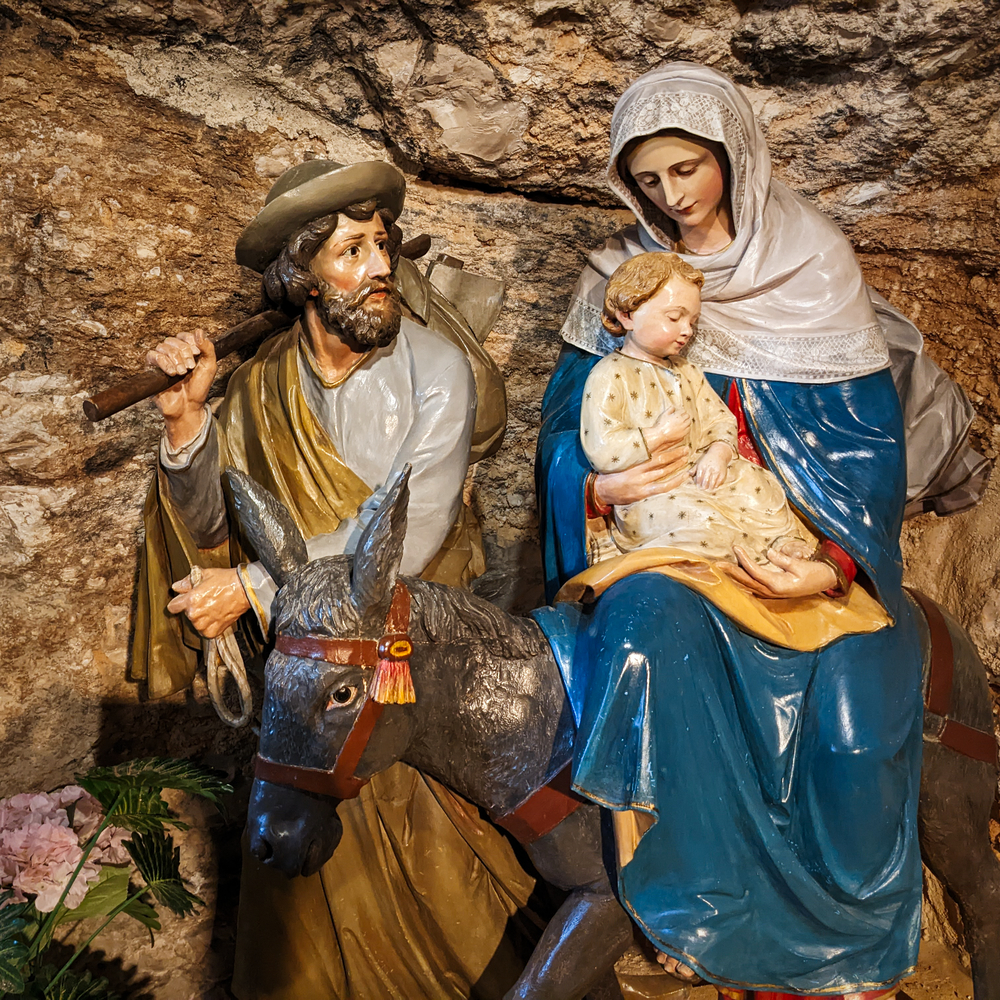
Mary and Joseph at the Milk Grotto
For most Bethlehem visitors, the Church of the Nativity is the main event (see PeriBlog X for details). Yes, there are other places to see in Bethlehem, but the cave where Mary gave birth and then laid baby Jesus in a manger captures the popular imagination.
Gift shops—filled with hand-carved olive wood tourist tat, Jesus soap dishes, rosaries, and other memorabilia of the Holy Land—stand in second place.
I pity the tour bus victims: sheep to be sheared.
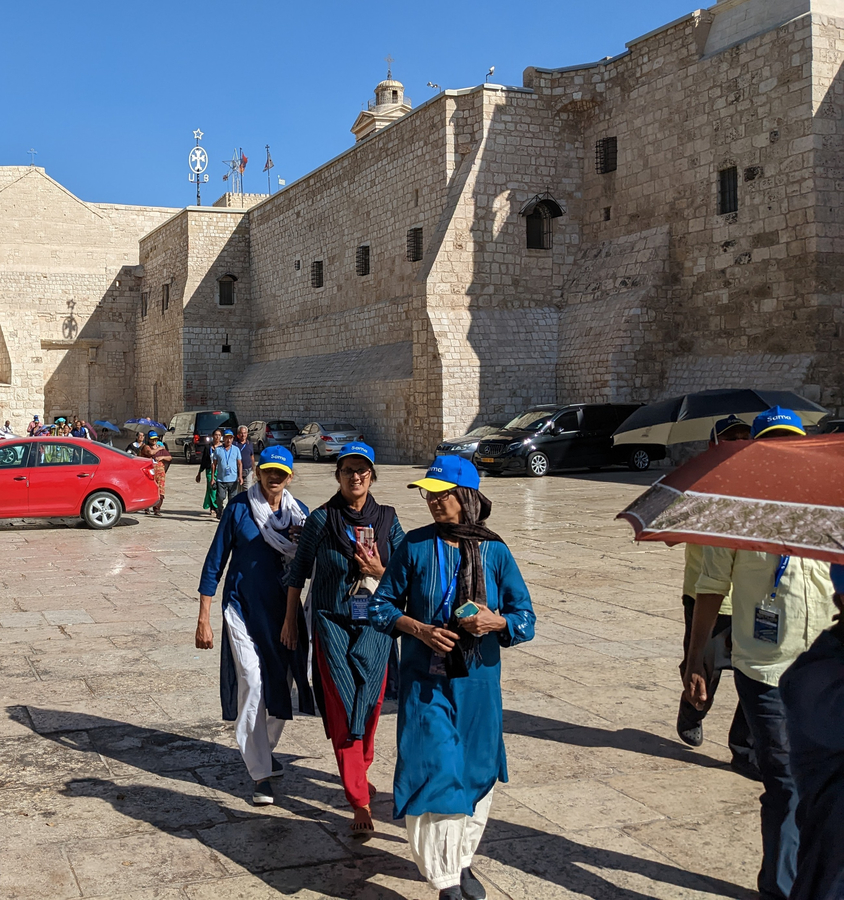
Turisti on the march
On my last morning in Bethlehem, I returned to pay a final visit to the sites around Manger Square. The tours were flowing; large white buses disgorged passengers from the United States, Germany, Italy, and probably every other country. Crowned with ugly baseball caps—blue, orange, hot pink, each group distinguished by its distinctive color—and earpieces to listen to the guide’s patter, they frogmarched up and down the square.
Fearing the onset of hives or boils, I ducked into the Franciscan retreat center next to the square. An outdoor cafe spread beneath the serene trees of this garden spot. The cafe was delightfully calm—one other man read a newspaper at a distant table. I grabbed a double espresso and sat with my notepad to compose a few Peripatetic thoughts.
Suddenly, I heard American voices. A swarm of turisti descended, packing in the tables around me. I was trapped like a misanthropic rat.
This particular group was assembling in advance of their day’s sightseeing. While waiting for stragglers to appear, the guide offered a short homily to keep interest simmering.
In Islam, he explained, men can marry four wives. Why is that?
The practice traces back to the biblical story of Jacob, Leah, and Rachel (Genesis 29). Jacob fell in love with the younger sister, Rachel. Rachel’s father, Laban, agreed to a marriage, if Jacob worked for him for seven years. On the wedding day, however, Laban substituted his older daughter (Leah), tricking Jacob. To pacify his new son-in-law, Laban said Jacob could marry Rachel as well if he worked another seven years.
He did, and ended up with two wives. These wives produced twelve sons, the progenitors of the twelve tribes of Israel. Jacob was a blessing on his wives and sons, the sons were a blessing on the land.
Many generations and thousands of years later, their descendants, the people of Palestine are a blessing on visitors to the land. In the same way, when Americans visit the Holy Land, they are a blessing on Palestine, learning about the country and supporting the economy.
That is why, concluded the guide, after the group visited the Church of the Nativity, he would escort them to a local gift shop where they could spend money to bless local artisans.
It was a complicated soliloquy; the moral, as I understood it, was that men should marry four women in order to produce more children who will spend money in gift shops.
Educational and inspirational. I weep when I think of what I miss by eschewing tours.
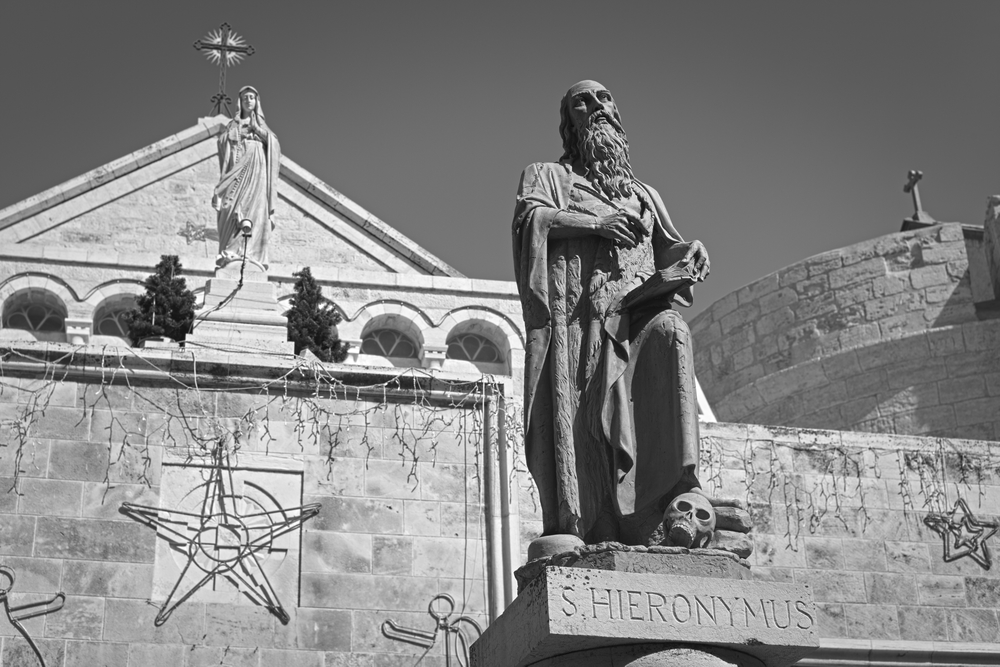
St. Jerome, doing his famous Stylite impersonation
Saint Jerome wasn’t keen on tours either.
After his sponsor, Pope Damasus, died in 386, Jerome faced the jealousy of the presbyters of Rome. Expecting to be named the next pope, he was surprised when his peers turned against him and drove him out of the city on a trumped-up morals charge.
He and his student/companion Paula visited the monks of the Egyptian desert, and then settled in Bethlehem. Drawing upon Paula’s generous purse, Jerome established twin monasteries—one for men, the other for women—next door to the cave of the nativity. Here he spent the rest of his days, translating the Bible into Latin, weighing in on theological controversies, and penning vitriolic letters about his adversaries.
Archaeologists believe that the Church of Saint Catherine, which shares a wall with the Church of the Nativity, is built on the foundations of Jerome’s monastery. There is no good reason to doubt this identification, although it not as clear that the cave below the church was Jerome’s study.

Once, Saint Jerome, Priest and Doctor of the Church, lay in this place
An inscription has been carved into the wall of “Jerome’s Cave” that claims Jerome, his brother Paulinus, Eusebius of Cremona, and Vincent the Priest, were interred in the cave. Jerome is no longer here. His body, according to tradition, was exhumed and transported to Rome, where (it is said) it now rests in the church of Santa Maria Maggiore.
The cave complex is fascinating. It actually connects to the Cave of the Nativity, but a locked door keeps visitors from avoiding the long lines upstairs by slipping into Jesus’ birth place through the back door. Jerome selected this spot for his monastery in order to be close to this holy site—he couldn’t have been much closer.
Like the Church of the Nativity, the Church of Saint Catherine is short on decoration. There isn’t much upstairs to detain the visitor. Therefore I don’t feel guilty moving through it quickly and heading off to visit the day’s second major attraction: the Milk Grotto.
According to tradition (I wonder how many times I will use that phrase as I write about these sites over the coming year), after Christ’s birth, Mary and Joseph took up residence for the two years in a nearby cave. To reach this cave, which stands about half a mile from the Church of the Nativity, one must walk east on a narrow street, past dozens of gift shops, each carrying unique and unmatched (handmade) treasures.
Gift shops tout call in lively voices as you walk past each stall: “Come inside. Best prices. Forty percent off for you, my friend. Where are you from? Hand-carved olive wood.”
The trick is to walk briskly, as if you are dashing to catch an airplane that is holding at the gate, waiting for you, the last passenger, to board. Don’t stop. Don’t hesitate. Go—they are about to close the airplane doors.
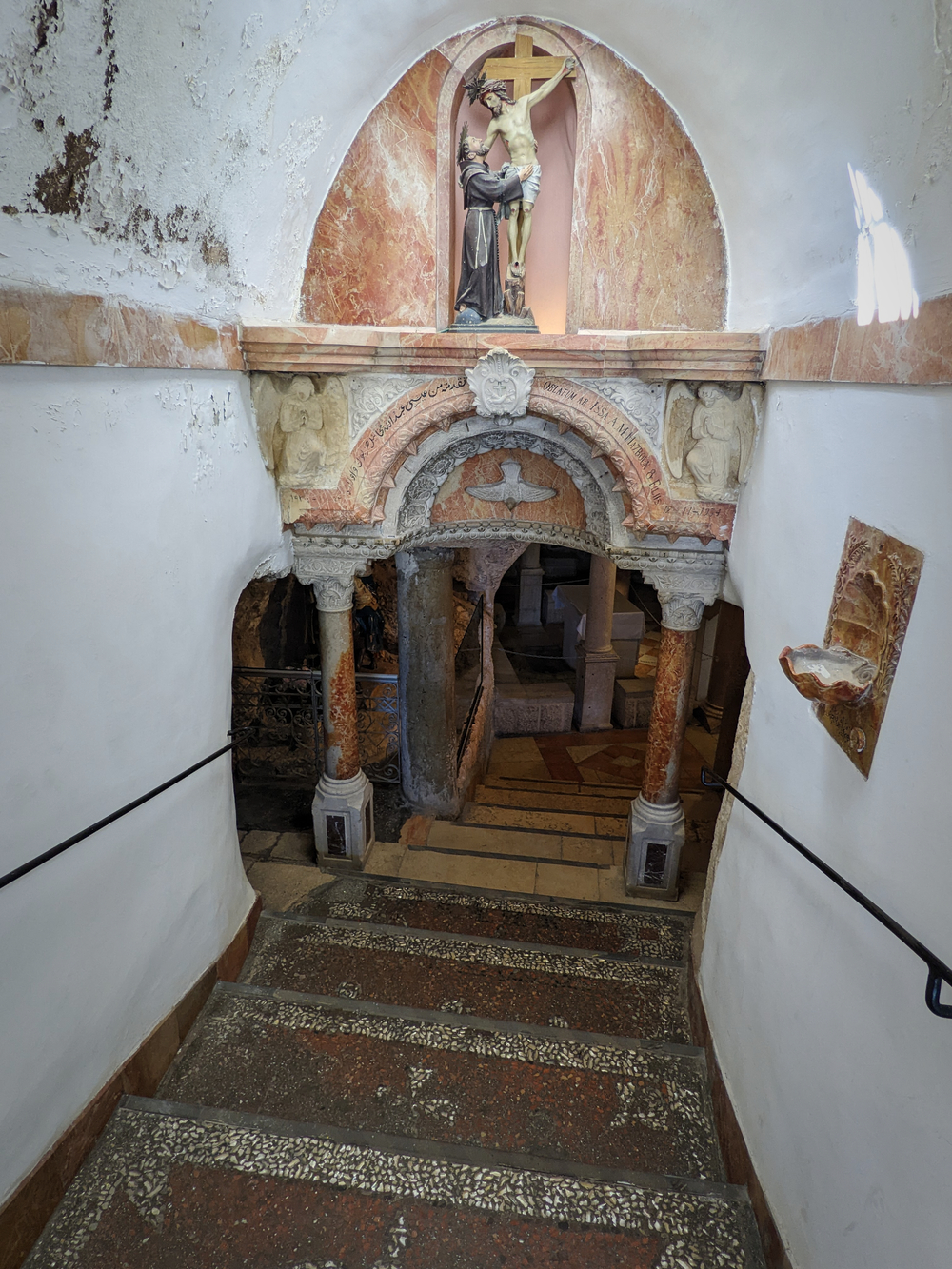
Stairs descend to the Milk Grotto
The touts fall away and I walk into a peaceful square. A staircase descends below ground, and I plunge into the cool cavern of the Milk Grotto.
The cave’s interior is a chalky white stone. According to tradition (there he goes again) while nursing Jesus milk would occasionally drip on the cave floor. Miraculously, this caused the interior to turn white.
German pilgrim Ida Pfeiffer noted in 1842: “The women in the neighborhood believe that if they feel unwell during the time they are nursing their children, they have merely to scrape some of the sand from the rocks in this grotto, and to take it as a powder, to regain their health.”
A similar belief persists today. Mary and I met a Franciscan friar who told us that several years ago a local priest had begun handing out vials of powder scraped from the cave walls to visitors who were struggling to conceive children. As time passed grateful parents began to send testimonial letters to Bethlehem, documenting childbirths that they attributed to the miraculous Milk Grotto powder.
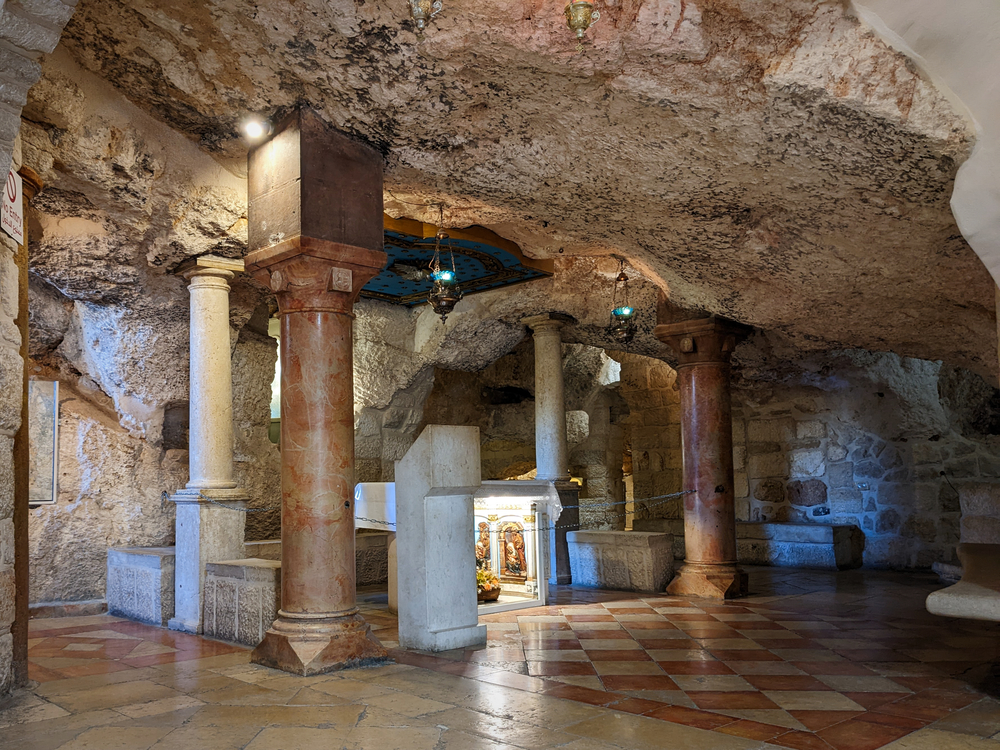
In the Milk Grotto
The Franciscans have more than 4,000 of these letters on file. The brother showed us his files. They hope to digitize the letters in the near future, creating an online archive to substantiate the local miracle.
Well, as everyone who has read the Gospels knows, King Herod heard about the infant King of the Jews living in the realm. He began a bloody campaign to root out a potential usurper—the massacre of the innocents—but Jesus, Mary, and Joseph avoided that persecution by slipping away to Egypt.
There is no biblical record of Jesus returning to Bethlehem.
If you are enjoying this series, why not subscribe to Richard's monthly newsletter, What's New in Old News? The Peripatetic Historian is on the road, roaming the world and compiling fresh adventures. Don't miss out. Click here to join the legions of above-average readers who have already subscribed.